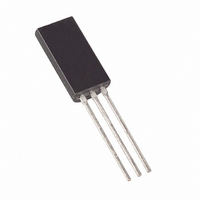DS1821 Maxim Integrated Products, DS1821 Datasheet

DS1821
Specifications of DS1821
Available stocks
Related parts for DS1821
DS1821 Summary of contents
Page 1
... DS1821 units can be programmed prior to system insertion for true standalone operation. The DS1821 has an operating temperature range of –55°C to +125°C and is accurate to ±1°C over a range of 0°C to +85°C. Communication with the DS1821 is accomplished through the open-drain DQ pin; this pin also serves as the thermostat output ...
Page 2
... Connect” pins. OVERVIEW Figure 1 shows a block diagram of the DS1821 and pin descriptions are given in Table 1. The DS1821 can operate as a standalone thermostat with user-programmable trip-points or as 8-bit temperature sensor with a 1-Wire digital interface. The open-drain DQ pin functions as the thermostat output for thermostat operation and as the data I/O pin for 1-Wire communications ...
Page 3
... SENSE GND TEMPERATURE SENSOR FUNCTIONALITY The core functionality of the DS1821 is its proprietary direct-to-digital temperature sensor, which provides 8-bit (1°C increment) centigrade temperature readings over the range of -55°C to +125°C. A block diagram of the temperature measurement circuitry is shown in Figure 2. This circuit measures the temperature by counting the number of clock cycles generated by an oscillator with a low temperature coefficient (temp-co) during a gate period determined by a high temp-co oscillator ...
Page 4
... MODE The DS1821 arrives from the factory in 1-Wire mode (T/R ¯ = 0). In this mode, the DQ pin of the DS1821 is configured as a 1-Wire port for communication with a microprocessor using the protocols described in the 1-Wire BUS SYSTEM section of this datasheet ...
Page 5
... DS1821 output temperature data is calibrated in degrees centigrade and is stored in two’s complement format in the 1-byte (8-bit) temperature register (see Figure 3), which the user can access when the DS1821 is in 1-Wire mode (T/R ¯ the status/configuration register). The sign bit (S) indicates if the temperature is positive or negative; for positive numbers and for negative numbers Table 2 gives examples of digital output data and the corresponding temperature reading ...
Page 6
TEMPERATURE/DATA RELATIONSHIP Table 2 TEMPERATURE +125°C* +85°C +25°C 0°C -1°C -25°C -55°C HIGH-RESOLUTION TEMPERATURE READINGS The user can calculate temperature values with higher than 8-bit resolution using the data remaining in the counter and slope accumulator when the temperature conversion ...
Page 7
... STATUS/CONFIGURATION REGISTER The status/configuration register provides information to the user about conversion status, EEPROM activity and thermostat activity. It also allows the user to program various DS1821 options such as power-up operating mode, thermostat output polarity and conversion mode. The status/configuration register is arranged as shown in Figure 5 and detailed descriptions of each bit are provided in Table 3. ...
Page 8
... TLF = 1 — At some point in time the measured temperature has been lower than the value stored in the T remain a 1 until it is over-written with the user. T/R ¯ — DS1821 powers wire mode. T/R ¯ — DS1821 powers up in thermostat mode. POL = 0 — Thermostat output (DQ) is active low. ...
Page 9
... The 1-Wire bus system uses a single bus master (i.e., a microprocessor) to control slave devices. The DS1821 functions as a slave device when it is used in 1-Wire mode; however, since the DS1821 is not addressable or multi-droppable, a single 1-Wire-mode DS1821 must be the only slave device on the bus. ...
Page 10
... DS1821. The presence pulse lets the bus master know that the DS1821 is on the bus and ready to operate. Timing for the reset and presence pulses is detailed in the 1-Wire SIGNALING section. ...
Page 11
... All communication with the DS1821 begins with an initialization sequence that consists of a reset pulse from the master followed by a presence pulse from the DS1821. This is illustrated in Figure 7. When the DS1821 sends the presence pulse in response to the reset indicating to the master that the bus and ready to operate given an appropriate function command. ...
Page 12
... There are two types of write time slots: “Write 1” time slots and “Write 0” time slots. The bus master uses a Write 1 time slot to write a logic 1 to the DS1821 and a Write 0 time slot to write a logic 0 to the DS1821. All write time slots must be a minimum of 60 μs in duration with a minimum μs recovery time between individual write slots ...
Page 13
... Master samples 45 μ μs VIH of Master 15 μ must be less than 15 μs for a read time slot. and T as short as possible INIT RC DS1821 pulling low MASTER WRITE “1” SLOT ∞ 1 μs < T < REC > 1 μs DS1821 samples MIN TYP 15 μs 15 μs 30 μs MASTER READ “ ...
Page 14
... DS1821 OPERATION EXAMPLE In this example, the master device programs the DS1821 with T that the data has been saved correctly. The master then programs the status/configuration register so that the device will power-up in thermostat mode (T/R ¯ and the thermostat output will have active high polarity (POL = 1) ...
Page 15
ABSOLUTE MAXIMUM RATINGS* Voltage on any pin relative to ground Operating temperature Storage temperature Soldering temperature *These are stress ratings only and functional operation of the device at these or any other conditions above those indicated in the operation sections ...
Page 16
AC ELECTRICAL CHARACTERISTICS: PARAMETER Temperature Conversion Time EEPROM Write Time Time Slot Recovery Time Write 0 Low Time Write 1 Low Time Read Data Valid Reset Time High Reset Time Low Presence Detect High Presence Detect Low V Low to ...
Page 17
TYPICAL PERFORMANCE CURVE Figure 11 MODE TOGGLE TIMING WHEN T/R ¯ Figure ...
Page 18
TIMING DIAGRAMS Figure ...












